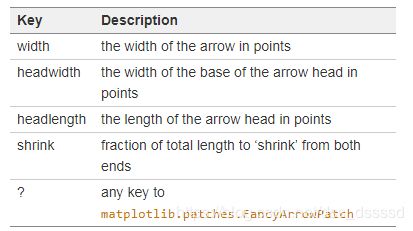matplotlib7 --文字注释 annotate() and text()
图的文字注释:
- annotate()
- text()
1. Axes.annotate(s, xy, *args, **kwargs)
用text s注释point xy
参数:
- s : str 注释文本
- xy: (float, float) 要注释的点(x, y)
- xytext: (float, float) optional s显示的位置。 默认xy
- xycoords: xy所采用的坐标系, 默认是’data’

- textcoords: xytext所采用的位置确定方法

默认是xycoords,既采用和xycoords一样的坐标系统。
-
arrowprops: 在xy和xytext之间指向箭头的属性 参数类型为dict
-
annotation_clip
当xy在Axes区域外时,是否还要注释- True: 只有当xy在Axes内是才注释
- False: 注释总是会被添加
- None:只有xy在Axes内并且xycoords是’data’才注释
**kwargs
其余的参数都传给Text
在之后的文章中会进一步介绍箭头的属性设置等更深入的话题
- 先看一个简单的例子:
fig = plt.figure()
ax = fig.add_subplot(111)
t = np.arange(0.0, 5.0, 0.01)
s = np.cos(2*np.pi*t)
line, = ax.plot(t, s, lw=2)
ann = ax.annotate("local max",
xy=(2, 1), xycoords='data',
xytext=(3, 1.5), textcoords='data',
# 设置字体相关属性
size=20, va="center", ha="center",
color='r',
bbox=dict(boxstyle="round4", fc="w"),
arrowprops=dict(arrowstyle="-|>",
connectionstyle="arc3,rad=-0.2",
fc="w"),
)
ax.set_ylim(-2,2)
plt.show()
- 一个相对完整的作图例子
import matplotlib.pyplot as plt
import numpy as np
x = np.linspace(-np.pi, np.pi, 128,endpoint=True)
cosx,sinx,x_3 = np.cos(x), np.sin(x), x / 3
#%%
fig = plt.figure(1)
axes0 = plt.subplot(111)
line1, line2 = axes0.plot(x, cosx, 'r',x, sinx, 'c')
line1.set_linewidth(2.5)
line2.set_linewidth(1)
# plt.xlim(x.min() *2, x.max()*2)
axes0.set_xlim(x.min() *1.2, x.max()*1.2)
axes0.set_ylim(cosx.min() * 1.2, cosx.max() * 1.2)
axes0.set_xticks([-np.pi, -np.pi/2, 0, np.pi/2, np.pi])
axes0.set_xticklabels([r'$-\pi$', r'$-\frac{\pi}{2}$', 0, r'$+\frac{\pi}{2}$', r'$+\pi$'])
axes0.set_yticks([-1, 0, 1])
axes0.set_yticklabels([r'-1', r'0', r'+1'])
# add legend
axes0.legend([line1, line2], ['y=cos(x)', 'y=sin(x)'])
# 轴居中
axes0.spines['right'].set_color('none')
axes0.spines['top'].set_color('none')
axes0.xaxis.set_ticks_position('bottom')
axes0.spines['bottom'].set_position(('data',0))
axes0.yaxis.set_ticks_position('left')
axes0.spines['left'].set_position(('data',0))
# 添加注释
t = 2 * np.pi / 3
# 通过将[t, 0], [t, np.sin(t)]连接起来使得图更好看一些。
axes0.plot([t, t], [0, np.sin(t)], color='c', linewidth=1.5, linestyle="--")
axes0.scatter([t],[np.sin(t)] ,s=50, c='c')
axes0.annotate(r'$\sin(\frac{2\pi}{3})=\frac{\sqrt{3}}{2}$',
xy=(t, np.sin(t)), xycoords='data',
xytext=(+10, +30), textcoords='offset points',
fontsize=16, color= 'c',
arrowprops=dict(arrowstyle="->", connectionstyle="arc3,rad=.2"))
# 同样对cosx做处理
axes0.plot([t, t], [0, np.cos(t)], color='r', linewidth=1.5, linestyle="--")
axes0.scatter([t],[np.cos(t)] ,s=50, c='r')
axes0.annotate(r'$\cos(\frac{2\pi}{3})=-\frac{1}{2}$',
xy=(t, np.cos(t)), xycoords='data',
xytext=(-90, -50), textcoords='offset points',
fontsize=16, color= 'r',
arrowprops=dict(arrowstyle="->", connectionstyle="arc3,rad=.2"))
plt.show()
- 看一个极坐标系的作图
fig = plt.figure()
ax = fig.add_subplot(111, polar=True)
r = np.arange(0, 1, 0.001)
theta = 2 *2 * np.pi * r
# 前两个是特例
# line, = ax.plot([4*np.pi]*1000, r, color='#ee8d18', lw=3)
# line, = ax.plot(theta, [1]*1000, color='#ee8d18', lw=3)
line, = ax.plot(theta, r, color='#ee8d18', lw=3)
# 在第800个点出注释
ind = 800
thisr, thistheta = r[ind], theta[ind]
ax.plot([thistheta], [thisr], 'o')
ax.annotate('a polar annotation',
xy=(thistheta, thisr), # theta, radius
xytext=(0.1, 0.1), # fraction, fraction
textcoords='figure fraction', # 从左下角开始,注释文字起始位置所占Figure总长度的比例(0~1)
horizontalalignment='left',
verticalalignment='bottom',
arrowprops=dict(arrowstyle="->", connectionstyle="arc3,rad=.2")
)
plt.show()





